 Diagnostics of diamonds, based on its finish (polish) quality and the presence of inclusions
Diagnostics of diamonds, based on its finish (polish) quality and the presence of inclusions |
Diamond differs from all the imitations in hardness, which is extremely high for diamond. That is why a cut diamond differs from an imitation in the quality of its finishing (especially polishing). Diamonds are also characterized by the presence of distinctive internal defects and inclusions. The finishing quality, internal defects, and inclusions may serve as direct or indirect diagnostic features.
To study the finishing quality, internal defects, and inclusions, a gemological loupe (a 10x triplet) or a binocular gemological microscope is used.
When viewing the studied sample under magnification, pay attention to the following indirect diagnostic features:
- Imitations often have abraded culet and edges, polishing traces, scratches and marks on facets, chips, non-flat facets, and curved edges. All these defects are not typical of diamonds.
| Chip on the surface of glass imitation.
|
|
 |
- Diamonds have characteristic inclusions (for example, pyrope, olivine, chrome diopside, some sulfides, diamond) that can be identified by appearance, size, shape, color, transparency, and relief.
| Two cracks under table in a polished diamond
|
|
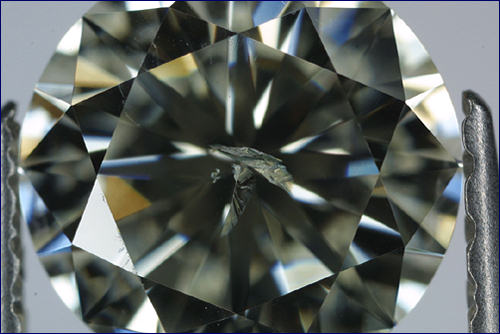 |
| Large crack in a polished diamond
|
|
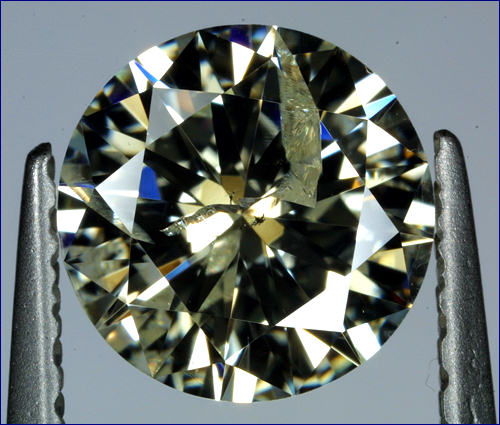 |
| Red garnet (pyrope) included in a polished diamond
|
|
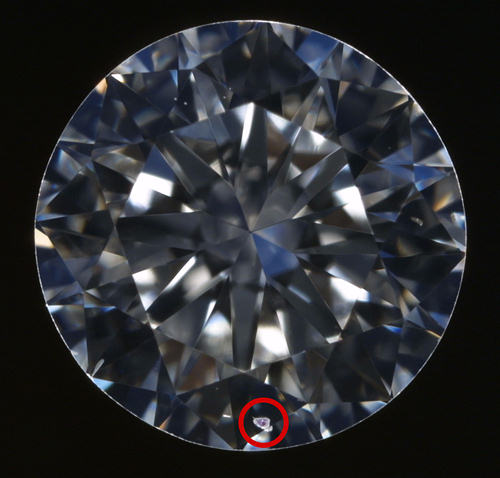 |
| Red garnet (pyrope) included in a polished diamond
|
|
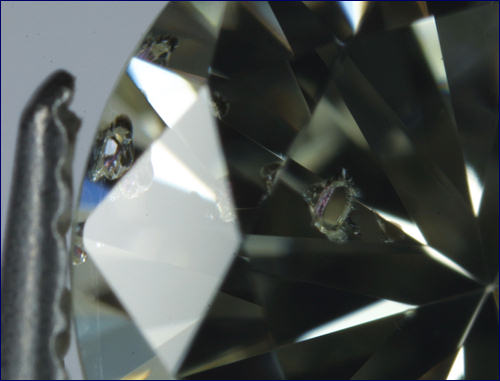 |
| Inclusion of spinel crystal in a polished diamond
|
|
 |
| Group of white pinpoints in a polished diamond
|
|
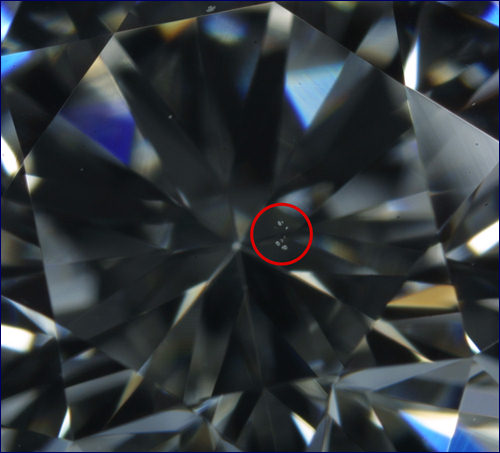 |
- Diamonds have characteristic features of internal structure, such as shear planes, twinning planes (twinning wisps), structure inhomogeneities, and some others.
| Dark twining line in a polished diamond
|
|
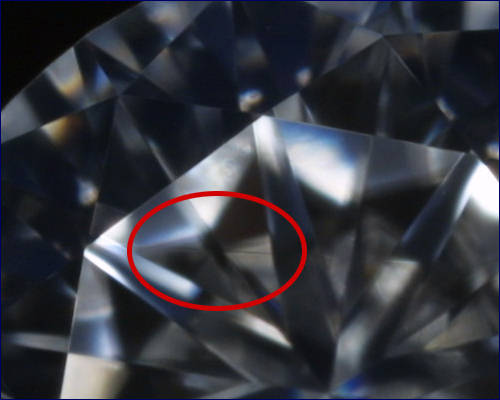 |
- When viewing a birefringent sample through its table, both inclusions and pavilion edges "double". Diamond is a singly refractive mineral (that is, shows no birefringence). Therefore, if testing a stone reveals its birefringence, it is possible to conclude that this is an imitation.
- Gluing traces, gas bubbles, or striaes in a gluing plane are features of a composite stone.
|
 Diagnostics of diamonds, based on a "dot method"
Diagnostics of diamonds, based on a "dot method" |
The "dot method" is based on total internal reflection of light, which takes place in round brilliant cut diamonds having accurate proportions. This method is applicable to transparent samples. It reveals all imitations with refractive indices lower than that of diamond and provides a gemologist with an indirect diagnostic feature.
The sample under study is put on a dot drawn with a dark ink on a white paper sheet. The table of the stone is bottom. For an imitation having a low refractive index, the dot can be seen through pavilion facets. For a diamond or an imitation having a high refractive index (moissanite, strontium titanate, rutile), there is no way to see the dot though pavilion facets. A disadvantage of this method is the fact that some cut styles and certain pavilion angles prevent the total internal reflection.
|
 Diagnostics of diamonds, based on the color and intensity of fluorescence
Diagnostics of diamonds, based on the color and intensity of fluorescence |
The most common color of diamond fluorescence is blue. However, the fluorescence can be also yellow, green, pink, or other. The color and intensity of the fluorescence are indirect diagnostic features. To excite the fluorescence, an ultraviolet lamp is used, the radiation of which has a wavelength of 365 nm.
| Blue long- wave U.V. fluorescence in a polished diamond
|
|
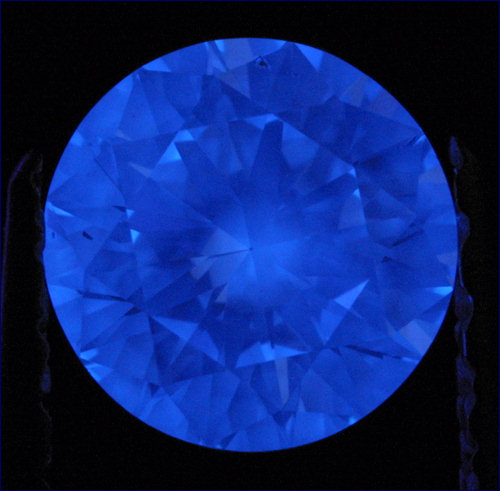 |
The observation of the fluorescence of the studied sample should be performed in a darkened room or after screening foreign illumination sources.
The color and intensity of the fluorescence as well as its distribution in the bulk of the sample are determined.
It is possible to conclude whether the studied sample is a diamond or not by comparing the results of the test with the UV fluorescence data contained in Table 2. If the observed fluorescence color is blue or yellow, the sample is possibly a diamond. If the fluorescence color is different (for example, red) and its intensity is high, the sample is probably an imitation. If there is a considerable difference between the color and/or intensity of the fluorescence from crown facets and pavilion ones, the sample is most likely a composite stone.
|
 Refractive index-based diagnostics of diamonds
Refractive index-based diagnostics of diamonds |
Most natural imitations of diamond have relatively low (less than 1.81) refractive indices. This fact is used in diagnostics of diamonds. Refractive index measurement allow one to unambiguously distinguish between a diamond and an imitation with a refractive index lower than 1.81 but fails to reveal an imitation with a refractive index higher than 1.81. The refractive index of a stone is an indirect diagnostic feature. To measure the refractive index, a refractometer is used.
If the measured value of the refractive index of the studied sample is lower than 1.81, it can be concluded that the sample is an imitation. Otherwise, the refractive index test fails to provide a final conclusion.
To increase the accuracy of the diagnostics, it is necessary to measure the refractive indices both at top and bottom facets of the stone. If the refractive indices considerably differ, the sample is most likely a composite stone.
|
 Table 1. Methods for diagnostics of cut diamonds and their imitations
Table 1. Methods for diagnostics of cut diamonds and their imitations |
Method |
Instrument |
Action |
Discrimination |
Notes |
| Heat conductivity measurement |
Duotester or Diamond-detector |
As a result of the test, a pointer moves across a scale (or a signal lamp lights up) |
All imitations except moissanite; composite stones |
Applicable for express-diagnostics of mounted and non-mounted stones |
.
| Reflectivity measurement |
Duotester |
A display shows the reflectivity value |
All imitations except moissanite |
Applicable for express-diagnostics of mounted and non-mounted stones |
| Specific gravity measurement |
Hydrostatic balance |
Weighing in a liquid and in the air (or immersion into a liquid of a known density) |
Imitations whose density differs from that of diamond |
Applicable to non-mounted stones only |
| Visual observation |
10Õ loupe or microscope |
Viewing the stone under magnification |
Imitations with distinctive features of the surface and interior; composite stones |
Applicable for diagnostics performed by a qualified expert |
| "Dot method" |
White paper sheet with a black dot drawn |
The stone is put on the dot (the table is down) and viewed from the pavilion side |
Imitations whose refractive index is less than that of diamond |
Applicable only to round brilliant cut diamonds with accurate proportions |
| Fluorescence test |
UV-lamp |
Fluorescence color and intensity are determined |
Imitations from fluorescent diamonds; composite stones |
Indirect diagnostic feature |
| Optic character test |
Polariscope |
Rotation of the stone sandwiched between two crossed polarizers |
All doubly refractive imitations |
Applicable for laboratory diagnostics of non-mounted and open mounted stones |
| Refractive index measurement |
Refractometer |
The refractive index is determined at a smooth polished surface and displayed on a scale |
Imitations whose refractive index is less than 1.81; composite stones |
Applicable for stones having a flat facet |
|
 Table 2. Diagnostic features of diamond and its imitations
Table 2. Diagnostic features of diamond and its imitations |
Material and its chemical formula |
Optic character |
Refractive index |
Hardness |
Dispersion |
UV fluorescence |
Specific gravity |
Additional features |
Diamond
Ñ |
Singly refractive |
(2,42) |
10 |
0,044 |
Blue, green, yellow (the intensity varies), or absent |
3,52 |
High heat conductivity, anomalous birefringence, mineral inclusions |
Phianite
ZrO2 |
Singly refractive |
(2,18) |
8,5 |
0,060 |
Weak yellow-orange or absent |
5,95 |
Gas bubbles (seldom) |
Zircon
ZrSiO4 |
Doubly refractive |
1,78-2,01 |
6-7,5 |
0,038 |
Moderate yellowish, orange, whitish |
3,95-4,80 |
Mineral inclusions, strong birefringence (edge doubling) |
Strontium titanate (fabulite)
SrTiO3 |
Singly refractive |
(2,41) |
6 |
0,109 |
Absent |
5,13 |
Very strong dispersion, gas bubbles, sharp traces of polishing |
Yttrium-aluminum garnet (YAG)
Y3Al5O12 |
Singly refractive |
(1,83) |
8,.5 |
0,028 |
Orange |
4,55 |
Gas bubbles |
Gadolinium gallium garnet (GGG)
Gd3Ga5O12 |
Singly refractive |
(2,03) |
6,5 |
0,022 |
Weak orange (S.W.) |
7,05 |
Gas bubbles |
Lithium niobate (linobate)
LiNbO3 |
Doubly refractive |
(2,25) |
5,5 |
0,075 |
Absent |
4,65 |
Perfect cleavage, gas bubbles, strong birefringence (edge doubling) |
Synthetic rutile
TiO2 |
Doubly refractive |
(2,62-2,90) |
6-6,5 |
0,190 |
Absent |
4,26 |
Gas bubbles, strong birefringence |
Yttrium aluminate
YÀlO3 |
Singly refractive |
(1,97) |
8,5 |
0,033 |
No data |
5,35 |
Gas bubbles, no fire |
| Glass |
Singly refractive |
1,44-1,90 |
5-6 |
0,009-0,098 |
Various |
2,3-4,5 |
Abraded edges gas bubbles, anomalous birefringence |
Quartz
SiO2 |
Doubly refractive |
1,544-1,553 |
7 |
0,008 |
Absent |
2,66 |
Gas-liquid inclusions |
Natural and synthetic sapphire (leucosapphire)
Al2O3 |
Doubly refractive |
1,76-1,77 |
9 |
0,011 |
Moderate blue (S.W.) or absent |
4,00 |
Very weak twinning, gas bubbles, inclusions |
Synthetic spinel
MgAl2O4 |
Singly refractive |
1,73 |
8 |
0,010 |
Various (from inert to strong) |
3,64 |
Gas bubbles, polishing traces, anomalous birefringence ("tatami" pattern) |
| Synthetic scheelite CaWO4 |
Doubly refractive |
(1,92) |
4,5-5 |
0,015 |
Pink, blue (S.W.) |
6,06-6,30 |
Curved growth lines, gas bubbles |
Topaz
Al2SiO4
(F,OH) |
Doubly refractive |
1,61-1,62 |
8 |
0,014 |
From weak to inert |
3,53 - 3,56 |
Mineral and gas-liquid inclusions |
Sphen (titanite)
CaTi[SiO4]O |
Doubly refractive |
(1,84-2,11) |
5-6 |
0,051 |
Inert |
3,29-3,56 |
Strong birefringence (edge doubling), fragility |
| Zincite ZnO |
Doubly refractive |
(2,02) |
4,5 |
0,060 |
Green |
5,55 |
Fragile |
Moissanite
SiC |
Doubly refractive |
(2,69) |
9,5 |
0,090 |
Inert or weak yellowish |
3,10-3,22 |
Strong birefringence (edge doubling) |
|
|